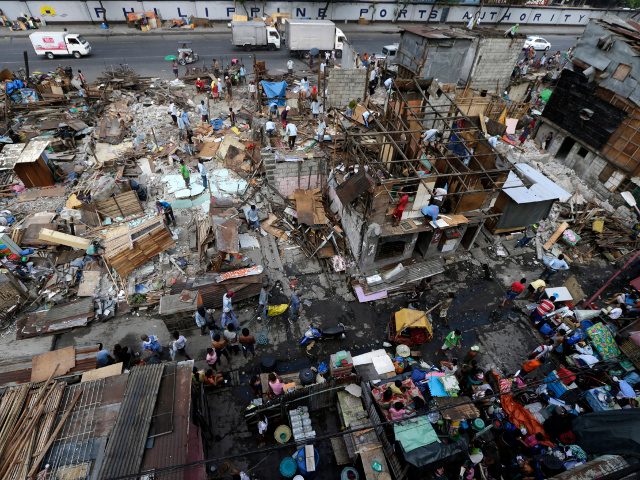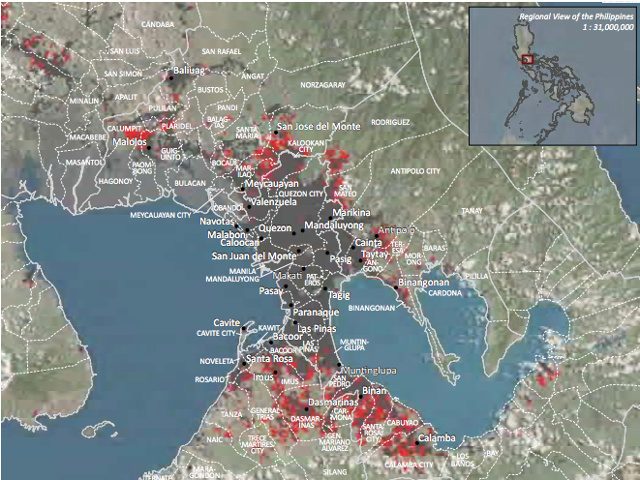SUMMARY
This is AI generated summarization, which may have errors. For context, always refer to the full article.

MANILA, Philippines – Land development in the Philippines’ urban areas failed to catch up with population growth from 2000 to 2010, making the country’s key cities the second most densely populated in East Asia.
This was according to a World Bank (WB) study released Monday, January 26, which said, “The population of the country that was ‘urban’ by this report’s definition (living in urban areas of more than 100,000 people) was 25% in 2010, lower than the proportion for the region as a whole (36%).”
The country had 10,300 people per square kilometer living in urban zones, behind South Korea which had an average of 10,500 people per sq km, according to the report “East Asia’s Changing Urban Landscape: Measuring a Decade of Spatial Growth.”
The Philippines’ urban population grew from 17 million in 2000 to 23 million in 2010, an average growth of 3.3% a year.
Increase in built-up land, however, did not catch up.
The country’s developed urban areas only grew by an average of 2.4% per year – or from 1,800 sq km in 2000 to 2,300 in 2010.
“Urban areas in the Philippines are among the densest in the region, and are becoming denser,” the report said.
No competition
The Philippine capital of Manila had the highest spike in concentration of urban population at 13,000 people per sq km in 2010, from 11,900 in 2000.
Its urban development only hit 1,300 sq km in 2010 from 1,000 sq km in 2000.
The Manila urban area is home to 16.5 million people in 2010.
The Manila urban area is the Philippines’ undisputed primary city, with no close competitors, the report said.
“In 2010, it had 56% of the urban land in the country and more than 70% of the country’s urban population, though these proportions decreased slightly between 2000 and 2010,” the report said.
In a conference at WB’s bureau in Singapore, Axel van Trotsenburg, WB’s vice president for East Asia, said population growth is at its thickest in Manila – and will continue so – as other cities and municipalities make urban development difficult due to bureaucracy.
“Many jurisdictions are involved in decision-making, which is a huge threat,” Trotsenburg told reporters in Manila via a video conference.
Develop infrastructure
The concentration of urban development in key cities, however, would make the Philippines’ economic growth far from inclusive, said Trotsenburg.
The Philippines has missing competitors to the capital, according to the report.
To facilitate urban expansion in other municipalities and cities, it said government must develop infrastructure outside Metro Manila.
“We need to ensure inclusive growth is throughout the country. That is important to see how the whole country grow together,” he said.
In November 2014, the IT and Business Process Association of the Philippines (IBPAP) said Metro Manila will remain as a preference among foreign locators due to its steady supply of office spaces, along with well-developed infrastructure.
Apart from Manila, the Philippines’ other urban areas include Angeles City, Bacolod, Cebu, and Davao.
These cities are also part of IBPAP’s “new wave cities” due to its increase in its business continuity, cost competitiveness, infrastructure, and talent pool.
Understanding urbanization
East Asia is also getting denser on average, as urbanization transforms the region.
Despite such significant and rapid growth, the data reveals that less than 1% of the total area in East Asia is urbanized, and only 36% of the total population is urban – suggesting that the region’s urban expansion has just begun.
Such growth, if managed properly, can also be good for the environment and can lead to more efficient provision of services to people, the WB report said.
But metropolitan fragmentation, with almost 350 urban areas spilling over local administrative boundaries remains a challenge.
“In some cases, multiple cities are merging into a single entity while they continue to be administered separately,” the report noted.
WB noted that local leaders are trying to understand this “transformation” but their response has been hampered by a lack of internationally comparable data because countries use differing definitions of urban areas and populations.
“The [World Bank’s] new data set was created to address this challenge by using satellite imagery and techniques for modeling population distribution, mapping all human settlements to achieve a common understanding of urbanization trends,” the report said.

The approach, according to the multilateral agency, can systematically establish where urbanization is occurring, how fast it is happening, and how population growth relates to increases in urban land area.
“Once cities are built, their urban form and land-use patterns are locked in for generations,” Marisela Montoliu Muñoz, director of the World Bank Group Social, Urban, Rural and Resilience Global Practice, said.
As such, improving the quality of data to understand trends in urban expansion is important.
“So that policy makers can make better-informed decisions to support sustainable communities in a rapidly changing environment, with access to services, jobs and housing,” Muñoz added. – Rappler.com
Add a comment
How does this make you feel?
There are no comments yet. Add your comment to start the conversation.